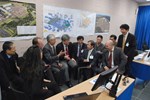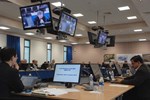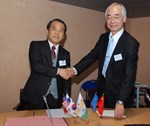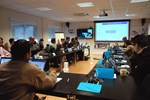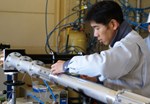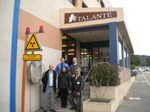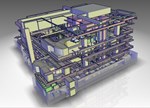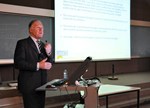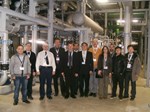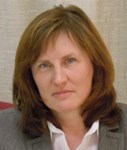ITER NEWSLINE

At its 10th meeting held on 26-27 January 2011, the ITER Management Advisory Committee (MAC) looked at a detailed analysis of additional direct investments that had been performed by the ITER Organization and the seven Domestic Agencies in response to the request from the ITER Council at its seventh meeting in November (IC-7).
These additional investments are the items deemed essential for the operation of the ITER machine, but that are not presently part of the ITER Baseline.
These additional investments are the items deemed essential for the operation of the ITER machine, but that are not presently part of the ITER Baseline.
The Baseline that describes the scope, schedule and cost for the construction phase of the ITER Project was approved by the extraordinary ITER Council in July last year.
The total value of the project's construction costs was capped at 4,700 kIUA*, including a contingency of 115.3 kIUA. It was agreed that any additional necessary resources were to be made available within this capped value.
During its meeting, the MAC developed guidelines that will be used to evaluate the allocation of responsibilities and credit values associated with additional direct investment based on the capped ceiling. Following these guidelines, future risks will now be accounted for.
During its meeting, the MAC developed guidelines that will be used to evaluate the allocation of responsibilities and credit values associated with additional direct investment based on the capped ceiling. Following these guidelines, future risks will now be accounted for.
MAC encouraged the ITER Organization to continue pursuing reduction in the overall cost of the ITER Project and efforts to accelerate its schedule.
* ITER Units of Account (IUAs) are the ITER "currency," a very unique feature of the ITER Project based on the principle of procurement sharing. Instead of contributing cash to the project, the Members will provide "in-kind" contributions; all of the components of the ITER facility will be built by the seven ITER Members and delivered to the ITER site in France. The IUA was devised in order to measure the value of in-kind contributions consistently over time, and neutralize market fluctuations.
http://www.iter.org/newsline/162/582-Sabina Griffith
Fusion World
ITER and NIFS about to enhance partnership
The ITER Organization and the National Institute for Fusion Science (NIFS), Japan, are about to enhance their partnership. On the occasion of the 40th meeting of the Fusion Power Coordination Committee meeting in Paris on 2 February, ITER Director-General Osamu Motojima and the Director-General of NIFS, Akio Komori, signed a Memorandum of Understanding that builds the framework for the technical cooperation between the two institutions.
In November 2009, the ITER Council had endorsed the ITER Organization's initiative to establish cooperation with research institutes, laboratories and other institutions in the ITER Member states. Following this newly established policy, NIFS, which has since 1998 successfully commissioned and operated the Large Helical Device (LHD)—the first-ever fully superconducting fusion device—has now signed the partnership agreement "for the mutual benefit that could be obtained from technical cooperation," it says in the Memorandum.
The principal objective of this cooperation is to provide opportunities for the exchange of ideas, information, technique, and expertise relating to the various research and development areas for ITER construction and operation. The scope and type of technical activities within this cooperation include cooperative and joint research activities on the cryoplant and cryo-distribution, superconducting magnet quality control, heat treatment, winding, CODAC, vacuum leak localization, power supply commissioning, integrated tests with superconducting coils, heating and current drive, and neutral beam injection.
Besides the exchange of expertise and information, researchers and staff will also be exchanged to train personnel, conduct seminars and engage in workshops in both institutions.
http://www.iter.org/newsline/162/580-Sabina Griffith
The fact that inside a fusion device it gets hotter than in the core of the sun leaves Hans Quack pretty cold. "Fusion is in fact 40 percent cryogenics," he says, and—being a professor for refrigeration and cryogenics at the University of Dresden—he knows.
At JET, cryogenics was already used for the vacuum cryopanels and for the handling of the fuel. The next step—using cryogenic refrigeration for the superconducting magnets—was pioneered at EAST, KSTAR and Wendelstein. But the ITER cryogenic system is an order of magnitude larger and much more complex than what has been built before, and is only comparable to the cryogenic system of the LHC at CERN.
The ITER machine will rely on a cryoplant, which will produce the required cooling power, and a cryo-distribution system to distribute the helium coolant to ITER's high-field magnets, cryopumps and thermal shields. "Cryolines will be crossing into the reactor," says Hans Quack "a situation that you don't have in a fission device."
This complex and sophisticated system of cryogenic transfer lines and manifolds was the subject of discussion at the ITER Headquarters last week during the conceptual design review of ITER's cryolines that was chaired by Hans Quack, and that brought together many international experts. "The very good level of preparation was recognized by the reviewers," said Luigi Serio, Responsible Officer for ITER's cryosystem, summarizing the review. "We are now sure that we have a robust design and that we can proceed with procurement of the cryolines for ITER."
The Procurement Arrangement is expected to be signed at the end of this month.
http://www.iter.org/newsline/162/581-Sabina Griffith
Gyro is ancient Greek for "circle," and tron—abstracted from "electron"—has been used since the late 1930s to name newly formed physics compounds.
Now, if you want to name a device based on the rotating motion of electrons, gyro and tron come in quite handy. By calling such a device a "gyrotron" you will convey a very clear notion of the principles it is based upon.
In a gyrotron, beams of electrons are accelerated toward a cavity where a strong magnetic field is applied. The interaction between the rotating (cyclotron) motion of the electrons and the magnetic field generate high-frequency radio waves that "travel" in a straight line, almost like an optical beam.
Gyrotrons are powerful devices that have very few applications: industry uses them as heating tools to process glass, composites and ceramics; in magnetic fusion, they contribute—along with ohmic and neutral beam heating—to bringing plasmas to the temperature necessary for fusion.
Gyrotrons are, essentially, energy-delivery devices.
Once generated in the magnetic cavity, high-frequency waves travel the length of a wave guide into an antenna that directs the beam into the plasma. The effect of the high-frequency wave on the electrons in the plasma is to accelerate their motion—another way of saying that electrons are "heated" by the high frequency beam.
The energy that the electrons have acquired is then transferred, by way of ions, to the whole plasma. This heating technique is called electron cyclotron resonance heating (ECRH). In ITER, the ECRH system will be composed of more than 20 gyrotrons which will deliver a combined heating power of 24 MW.
"The area of the plasma that is impacted by the beams is rather small," explains Caroline Darbos, an engineer with the ECRH team, "but the energy spreads fast and evenly. The beams accelerate the electrons in the plasma, which, while generating current, communicate their newly acquired energy to the ions."
High frequency beams fulfil a second important role in fusion devices: when aimed precisely by way of a mobile mirror system, the current that is generated by the electrons can also suppress local instabilities in the plasma.
The ECRH system is presently in its conceptual design phase, and India, Russia, Japan and Europe are all developing prototypes for the ITER gyrotrons. For three days in January, representatives of these four countries met at ITER to report on progress on the ECRH and high-tension power supply systems (the power supply's characteristics are directly related to those of the gyrotrons).
"Progress is constant," says Darbos "but we are all working at the limits of technology. We have no experience in steady-state gyrotron operations: the DIII-D tokamak operated by General Atomics in San Diego has experience with high frequency pulses of a couple of seconds only, and the Wendelstein 7-X Stellarator, which will implement 10MW of steady-state gyrotron power, is not yet operational."
The difficulties are real and there is still a long way to go between prototypes and serial production. However in Lausanne, Karlsruhe, Moscow, Nijni-Novgorod, Naka and soon in Ahmedabad, prototypes are being fine-tuned and test beds readied.
Late this year or early in 2012, a first gyrotron Procurement Arrangement should be signed with Russia.
http://www.iter.org/newsline/162/577-Robert Arnoux
Nuclear World
Touring hot cells in CEA-Marcoule
"In a hot cell environment, the simplest solution is always the best... " This was one of the recommendations made by nuclear operators in CEA-Marcoule to a delegation visiting from ITER.
The five-person ITER delegation visited three nuclear installations in Marcoule: Atalante, Phenix and Melox.
Atalante is a facility that is dedicated to research and development in the field of spent fuel, from dissolution to vitrification. The delegation had several discussions regarding maintenance operations and rescue scenarios.
The "red zones" in the installation are not accessible for safety reasons and all operations are performed remotely. For the operators, any type of failure must be considered at an early stage of design. If design fails to anticipate the consequences of a failure, the hot cell can be rendered unusable during shutdown and recovery operations can become very costly.
While much smaller in scale, the hot cell in Phenix has many similarities with the planned ITER Hot Cell Facility. Composed of two units—one on the ground floor and another at basement level—maintenance areas are localized on the first floor.
Despite its compact design, Phenix's hot cell layout was flexible enough to allow the addition of a second cell after a few years of operation. Cells are filled with inert gas (nitrogen) to prevent hazards arising from the presence of sodium on the fuels. Phenix is a fast neutron reactor prototype that uses liquid sodium as coolant.
Melox was the third nuclear facility visited by the delegation. The installation manufactures fuel assemblies destined for light water nuclear reactors operating on MOX (mixed oxide fuel), a nuclear fuel elaborated from a homogeneous blend of uranium and plutonium oxides.
Safety, availability and efficiency are key drivers for the operators. Production in Melox (200 tonnes/year) has doubled since 1997. The operators emphasized the advantage of implementing proven and robust—sometimes referred to as "agricultural"—technologies, and also highlighted the need for automation and remote control for optimized production.
The ITER Hot Cell Facility will be one of the largest in the world. Because of the size of the components to be handled and maintained and also the complexity of some of the processes, the challenges to be faced are considerable.
Visiting similar facilities, building on lessons learned there, and benefitting from feedback is absolutely crucial to optimizing the design of a safe Hot Cell Facility for ITER.
http://www.iter.org/newsline/162/575-Alexis Dammann, Hot Cell and Radwaste Facilities Integration Section
On Site
Money talks
Why was it necessary to invent the ITER Unit of Account, or IUA? What is the difference between the planned value of ITER and its actual cost? Does ITER earn interest on the funds it holds, and —if so—where does this money go?
Hans Spoor, Head of Finance & Budget, addressed these questions and more at this week's Inside ITER seminar. Entitled "Everything you wanted to know but were afraid to ask about ITER finances," the audience was introduced to the specificities of ITER financing by its Members, budget planning and procedures, and principles of ITER accounting.
ITER construction will be managed within an agreed capped ceiling of 4700 kIUA. "Converted to euros at 2010 conversion rates (1 IUA = 1,552.24 euros), that's EUR 7.3 billion," demonstrated Hans. "ITER construction costs are equivalent to less than 20 euro cents/year for the inhabitants of the ITER Member countries."
http://www.iter.org/newsline/162/576-Krista Dulon
Fusion World
Fusion Expo on stage in Bratislava
The Fusion Expo, a travelling exhibition designed to be accessible to the general public, is currently on stage in Bratislava, the capital of Slovakia. The extensive exhibition presents various aspects of fusion as an environmentally-acceptable, safe and sustainable energy technology. In a clear and simple way, it explains the fundamentals of fusion, describes Europe's fusion research facilities, introduces the ITER Project, and looks ahead to the construction of a working fusion power plant.
The Fusion Expo will remain in Bratislava until 18 February and then move on to the magnificent Prechtlsaal in Vienna where it will be open from 1-10 March.
For more information on the Fusion Expo click here.
http://www.iter.org/newsline/162/583
The RAMI & Standardization Board held its 7th Meeting at European Domestic Agency headquarters in Barcelona.
RAMI stands for reliability, availability, maintainability and inspectability. It describes a process whose primary purpose is to make sure that all systems in the ITER machine will be available during the operation phase and will maintain their performance under operational conditions.
Representatives from the ITER Organization and the Domestic Agencies met or attended remotely to report and discuss new results obtained in the framework of the ITER RAMI approach and standardization process, and to validate the work program for the coming year.
The Board particularly appreciated the participation of a new member, Grigory Konovalov, representing the Russian Federation, as well as the attendance of several European Domestic Agency Responsible Officers which allowed direct interaction between the Board and the technical staff in charge of the procurement in Europe.
The meeting began with the presentation of the latest RAMI analyses and results regarding the diagnostics, the central interlock and safety systems and the cryoplant. The first iteration of RAMI analyses is drawing to a close; 27 plant systems have been analyzed since 2008 and all systems will have been covered by 2012.
The second day was dedicated to the ITER standardization effort, with a review of 2010 feedback and presentations by the working groups. The decision was made to use the Project Change Request process to implement the requirements and recommendations issued by the Board.
The 2011 work plan will focus on finalizing the technical specifications for the electrical motors, cryovalves, heat exchangers and water pumps for the cooling water system, and sensors and connectors before expanding the work to other components such as the other valves and cameras for safety and operation.
Regarding PCR-300, the ongoing Project Change Request for updating the RAMI requirements and the update of the RAMI targets in the Project Requirements, the Board expressed its support to the new ITER Organization approach to define the requirements as availability targets per main function, rather than per plant system.
The last day of the meeting was devoted to the contribution of the Domestic Agencies to both RAMI and standardization programs.
The Board members were also invited by the European agency to visit the Alba Synchrotron Light Source located near Barcelona, which is nearing the end of its commissioning phase.
http://www.iter.org/newsline/162/584-Didier van Houtte, RAMI & Standardization Board chairman
Fusion World
New Scientific Director at IPP Garching
On 1 February, 2011, Professor Sibylle Günter took up her new appointment as Scientific Director of the Max Planck Institute for Plasma Physics (IPP) at Garching and Greifswald.
She succeeds Günther Hasinger, who had headed IPP since 2008. IPP's research objective is to develop the principles for a fusion power plant.
Sibylle Günter is a professor of theoretical physics and has been with IPP for fourteen years now, latterly as head of the Tokamak Theory Division. Her research field is theoretical plasma physics, her main areas being magnetohydrodynamics and kinetic theory of suprathermal particles.
As new director, she aims to bring the two branches of IPP at Garching and Greifswald even closer together, "in order to ensure jointly the best possible use of the two large-scale experiments, the ASDEX Upgrade tokamak device at Garching and the Wendelstein 7-X stellarator, which is to go into operation at Greifswald in 2014. IPP is the only institute in the world equipped to do comparative research on devices of both types, thus enabling it to develop the optimum concept for a power plant—a most exciting objective."
http://www.iter.org/newsline/162/585
